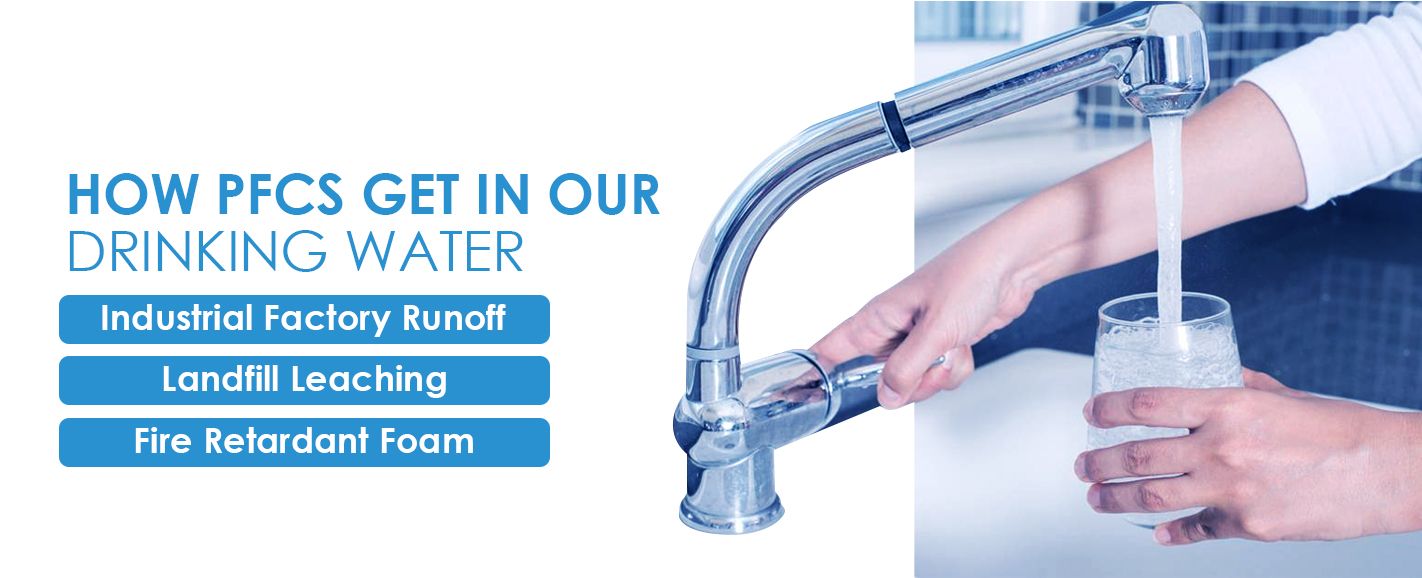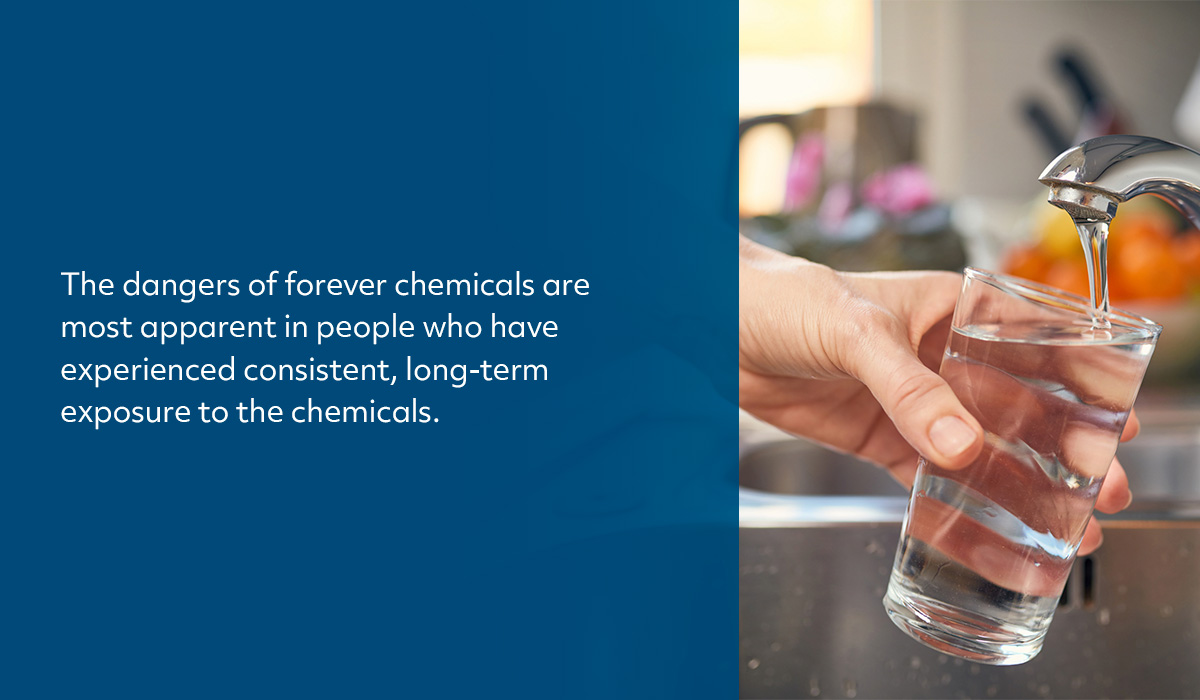Forever Chemicals Contamination in Drinking Water
Posted by Kenton Jones on Sep 29th 2022
Across the country, the levels of forever chemical contamination have reached serious levels. Over 200 million Americans drink water laced with these forever chemicals, so-called because they take a long time to break down. Whether we know it or not, these chemicals have silently slipped into most of our groundwater and drinking water sources.
Forever chemicals are linked to many dangerous health effects, posing a risk to humans as well as the environment — which is why you need to understand the nature of these chemicals, how they migrate into waterways, their effects on human health, and what steps you can take to reduce them in your water.
What Are Forever Chemicals?
Perfluoroalkyl substances (PFAS), perfluoroctane sulfonate (PFOS), and perfluorooctanoic acid (PFOA) are all considered forever chemicals. This group of synthetic chemicals is used to manufacture products that resist water, grease, oil, stains, and heat. This means that forever chemicals, and the compounds considered to be part of this group, are incredibly stable chemicals, able to withstand extreme conditions without breaking down.
PFOS, PFOA, and PFAS are called forever chemicals because they won't degrade easily in the environment — when forever chemicals enter an ecosystem, they remain intact.
Chemicals within the broad category of forever chemicals belong to one of two groups — short-chain and long-chain forever chemicals. Short-chain forever chemicals have less than six carbon molecules per compound, and they typically are less stable and degrade faster. Long-chain forever chemicals have two subcategories — perfluoroalkyl sulfonic acids and perfluoroalkyl carboxylic acids. Long-chain forever chemicals are of particular concern in the environment — more difficult to degrade, these compounds persist in water, soil, and the bloodstream for years.
Both short and long-chain forever chemicals have been found in water systems across the nation. The U.S. Environmental Protection Agency (EPA) along with many state governments has established guidelines for forever chemical concentration in drinking and source waters. Currently, the federal government is working to set enforceable limits for forever chemical compounds in drinking water.
Here's just one state example — Massachusetts Attorney General Maura Healey filed a lawsuit against 13 manufacturers that she argues knowingly contaminated several water systems in Massachusetts with the forever chemicals they produced. The Attorney General stated that the manufacturers repeatedly defied state and federal laws protecting drinking water by marketing and selling products containing forever chemicals despite knowing the harm they cause to communities and the environment. Massachusetts Governor Charlie Baker stated his administration spent over $110 million to address forever chemical contamination in the state.
Forever chemicals are common chemicals in our lives — you can find them in everything from the coating of a frying pan to the lining of a bag of microwave popcorn. Below are only a few examples of objects containing forever chemicals:
- Non-stick cookware: Non-stick cookware is a staple product in most homes. After cooking a meal, the last thing you want is to scrape away at encrusted oils and residue. Despite the convenience of non-stick surfaces, research suggests thatnon-stick cookware could be toxic, primarily due to the presence of forever chemicals. When the pan is heated, forever chemicals can be released in the air, potentially entering our bodies and the environment of our home.
- Stain-resistant carpets and fabrics: No one likes stains, especially if accidents happen on expensive sofas or rugs. Forever chemicals give stain-resistant properties to fabrics, but over time, the chemicals leach out of the material and enter the rest of our homes, including water sources.
- Coatings on food packaging: If any product has been designed to withstand high heat, look for forever chemicals — they will almost always be a contributing component to the item. Microwave-safe products and packaging, in particular, are full of forever chemicals, including microwave popcorn. While the chemicals help the product survive the intense heat, they may also pass into our food. Forever chemicals are also common in fast food bags and wrappers for their grease-resistant properties.
- Water-resistant clothing: Whether it's your favorite raincoat or durable backcountry tent, many water-resistant fabrics contain forever chemicals. As the elements wear on these outdoor materials, forever chemicals leach away into the environment.
- Sealed flooring: Treated floor waxes, along with tile, stone, and wood sealants, are known carriers of forever chemicals. As the treatments and sealants gradually wear away, the small amounts of forever chemical-laced dust enter the air and are absorbed through the lining of the lungs.
Almost every American household has forever chemical-containing products, but the problem is amplified if you live close to major industrial centers. Forever chemicals are commonly used in industrial contexts such as electronics manufacturing and plastic production. The benefits of forever chemicals have made them an asset to industrial production for decades — but we are only now beginning to see their negative long-term impacts.
What Are the Types of Forever Chemicals?
Forever chemicals consist of over 12,000 synthetic chemicals that don't naturally occur in nature. The list is diverse and includes polymers, partially-fluorinated substances, and other types of chemicals. The EPA is working to identify and research these chemicals further to gather a more complete picture of their impact on humans and the environment.
The three most common types of forever chemicals include:
- Perfluoroalkyl substances: Perhaps the most well-known forever chemicals include perfluoroalkyl substances, a group of carbon and fluorine atoms that may repeat multiple times to form polymers. PFAS are found in products, water, soil, fish, and air across the U.S. The EPA has identified thousands of PFAS in uses ranging from household cookware to industrial products.
- Perfluoroctane sulfonate: A widespread forever chemical classified as part of the PFAS chemical group is perfluoroctane sulfonate. PFOS has been used in products that are resistant to water, grease, oil, and stains, although the major manufacturer of the chemical ended production in the early 2000s. PFOS has been linked to cancer and congenital disorders
- Perfluorooctanoic acid: Perfluorooctanoic acid was frequently used in a variety of products. Animal and human studies have found a link between PFOA and cancer, and the International Agency for Research on Cancer has classified PFOA as a possible human carcinogen. The EPA has not officially classified PFOA as a carcinogen, but the chemical is no longer manufactured in the U.S. Many manufacturers are replacing PFOA with perfluorobutanesulfonic acid (PFBS), which hasn't been in use long enough for researchers to determine its effects.
How Forever Chemicals Get in Our Drinking Water
Because forever chemicals are such a stable compound, researchers have found buildups of the chemicals in sediment deposits, soil, water, and even the human bloodstream. Forever chemicals enter into drinking water in countless ways — it can happen when the trace forever chemicals in microwave popcorn get washed down a kitchen drain or when the elements wear down a water-resistant backpack on a hike.
Forever chemicals are also highly soluble in aquatic environments, which means that they dissolve — but don't degrade — in almost any water source. Researchers have noted forever chemicals in lakes, tributaries, rivers, and groundwater, and the contamination keeps rising. In part, this is because of how few forever chemicals it takes to pollute a water source.
The amount of forever chemicals in the environment is measured in parts per trillion — the level of forever chemicals in a water system that could cause negative health outcomes only needs to be0.004 parts per trillion. This makes the pollution of industrial complexes even more of a threat because they contribute more forever chemicals into the environment than any other source.
Three of the major sources of forever chemical contamination in drinking water are industrial factory runoff, landfill leaching, and fire retardant foam.

1. Industrial Factory Runoff
Most often, high forever chemical counts are in sites near industry discharge points — the greatest contributors to forever chemical pollution are large-scale military or industrial operations that leach the chemicals into water systems.
Forever chemicals are used in many manufacturing processes including the production of plastic and electronics. Grease and heat-resistant, forever chemical compounds are viewed as essential for many industrial settings, where both heat and grease are abundant.
But the results can be severe. Factory runoff contributesmassive amounts of pollution to ground and drinking water, dumping forever chemicals into the environment in large quantities. Areas with significant industrialization almost always face dangerous levels of forever chemicals in their drinking water.
2. Landfill Leaching
Forever chemical pollution doesn't have to be recent to be dangerous.
Our landfills pose many significant problems for forever chemical contamination. For the people of St. Paul, Minnesota, the consequences of landfill forever chemicals have taken a personal turn. Officials shut down several city wells after discovering dangerous levels of forever chemicals in the city's drinking water.
The source was a 3M chemical dump from the 1940s. Forever chemical production at the factory was phased out by 2002, but the problem recently worsened. The contamination affects about 174,000 Minnesota residents and 150 square miles of groundwater. The Minnesota Department of Natural Resources and Pollution Control Agency are working to provide residents with clean drinking water by building new city wells and private wells and providing some residents with in-home water filters. Across the state, forever chemicals have contaminated groundwater by nearly 60 closed landfills.
3. Fire Retardant Foam
Firefighting is a dangerous, heroic, and vital job in any society. But the modern foam used to subdue fires isn't necessarily eco-friendly — many formulas are filled with forever chemical compounds. As the foam is sprayed into a fire, these chemicals are released into the air. Additionally, as the rubble from a fire is washed away with water, forever chemicals can be swept into water systems.
From small urban accidents to large-scale airplane fires, firefighting foam is used in large quantities in a variety of contexts — even during emergency training, when a real fire isn't present. Hydrocarbon fires can't be put out by water, and rely on Aqueous Film-Forming Foam (AFFF) to smother dangerous and explosive fires. Heavily urbanized areas and sites near military bases typically experience higher forever chemical levels, asPennsylvania resident Lori Cervera learned the hard way.
In 2014, an otherwise healthy and active Cervera suddenly developed kidney cancer. After her diagnosis, tests revealed that a nearby abandoned military facility had contaminated the local water with forever chemicals. The rest of the nation slowly took notice, and the Department of Defense later warned Cervera to stop drinking or using her water immediately.
Although companies are developing new firefighting foams that don't include forever chemicals, the lingering effects of decades of forever chemical-filled foam continue to cause problems for communities and the environment.
The Effects of Forever Chemicals in Drinking Water
Researchers claim that the combination of large-scale industrial contamination and small, daily forever chemical pollution is linked to serious health problems. While almost everyone has detectable levels of forever chemicals in their bloodstream, many don't experience any noticeable side effects — the dangers of forever chemicals are most apparent in people who have experienced consistent, long-term exposure to the chemicals. The full effects of forever chemicals on human health are still being researched, but current studies point to several major health effects in the following areas.

1. Reproductive and Developmental Issues
Forever chemicals have been linked toseveral reproductive and developmental issues, particularly with fetuses during pregnancy and breastfed infants.
- Reduced female fertility
- Pre-eclampsia, orpregnancy-induced hypertension
- Low birth weight
- Premature birth
- Skeletal variations and congenital disorders
- Accelerated puberty
- Development of attention deficit hyperactivity disorder (ADHD)
While the full connection between forever chemicals and reproductive issues is still unknown, most research points to a concerning correlation — the higher the levels of forever chemicals in the parent's blood, the more the child is at risk for developmental problems.
2. Cancer
Once in the bloodstream, forever chemicals do not metabolize. Instead, they bind to proteins and are distributed to three main areas in the body — the liver, kidneys, and blood. Consequently, these are the areas that are at the most risk of developing forever chemical-related cancer.
Below is a list of the types of cancermost associated with high forever chemical levels.
- Testicular cancer
- Kidney cancer
- Ovarian cancer
- Childhood leukemia
- Prostate cancer
In 2022, the EPA recommended that the U.S. classify forever chemicals ashazardous substances, but the chemical is still widely used in various applications.
3. Immune Function
Research connecting forever chemicals and immune function has been conducted through animal models and human studies. The results are concerning — all indicators point to a worrying link between high forever chemical levels and asuppressed and inefficient immune response.
Researchers have linked forever chemicals with the following immune insufficiencies:
- Suppressed hormonal immune response
- Reduced production of lymphocytes
These results reduce the body's ability to fight off bacterial invasions and enhance its response to allergens, increasing the severity of allergic reactions.
4. Thyroid and Hormone Imbalance
Forever chemicals are endocrine disrupters, which means it takes very little of these chemicals to interfere with an entire hormonal system. Studies have linked forever chemicals withseveral hormone imbalances, including:
- Abnormal endocrine activity
- Hypothyroidism
- Thyroid disease
Only a small amount of forever chemicals is required to disrupt hormone function, putting communities around military and urban centers at risk.
5. Other Effects
As results from new studies continue to develop, forever chemicals are increasingly connected with a wide range of other serious conditions, including:
- Liver damage
- Increased cholesterol levels
- Increased uric acid, a marker of heart disease
Although further studies are needed to confirm early research, the current findings are enough to worry the health and science community. In 2015, over 200 scientists signed the Madrid Statement to express concern about the chemicals, indicating a widespread awareness and uneasiness about forever chemicals' presence in our water systems.
How Are Forever Chemicals Being Regulated?
Discussion about forever chemical regulation has been ongoing for years. The EPA has at last set forth an action plan for regulating the substances. This plan includes:
- Labeling certain forever chemicals as hazardous substances: This action would hold manufacturers accountable for production of the chemicals and increase transparency about their release into the environment.
- Potentially requiring forever chemical cleanup: Once they reported releasing any forever chemicals, manufacturers would need to clean up the site. The EPA would also require the responsible party to cover the costs of cleanup.
- Releasing drinking water advisories: The EPA released four health advisories pertaining to the impact of PFAS pollution.
At the state level, several governments have also enacted legislation regulating forever chemicals. Michigan lawmakers recently passed strict limits on forever chemicals in the water, and 31 other states are considering policies. These laws center around regulating the use of forever chemicals, keeping manufacturers accountable, and allocating resources for cleanup. Other proposed bills limit the use of forever chemicals in cosmetics and children's products. These actions are often in response to the federal government's lack of strict enforcement yet.
How to Avoid Forever Chemicals in Your Drinking Water
The problem of forever chemicals is still not solved, but it's possible to reduce your exposure.
Check this map that traces forever chemical pollution to see if your area has tested positive for contamination. If you suspect your water might contain forever chemicals, the next step is to test your water. Contact your public water system to learn about the last time your system was tested for forever chemicals, and ask for the results of the test. For more detailed analysis, send a sample of your water to a lab or water testing service to determine the forever chemical concentration in your water.
If your water contains forever chemicals, evaluate your home for items that contain the chemicals. Switch out traditional non-stick cookware for non-toxic alternatives, and start popping your popcorn on the stove. With a few changes, you can reduce the amount of forever chemicals introduced into your environment, although existing forever chemicals will be hard to target.
The best solution for reducing forever chemicals in your water is through a carbon block filtration system. These systems use incredibly fine filtration technology to reduce a variety of contaminants from a water source. Carbon block filters use a combination of physical adsorption, chemical reaction, and mechanical filtration to treat your water without removing beneficial minerals.
You can find excellent carbon block filters in a range of sizes, though not all filtration systems are the same. If you want your filter to treat forever chemicals, look for third-party certification from NSF. Certification for forever chemicals under NSF Standard 53 indicates that the filter has been performance tested to reduce PFOA/PFOS. By addressing sources of forever chemicals in your home and investing in a superior carbon block filter, you will go a long way in reducing your exposure to the toxins.
Treat Your Water With Multipure Filtration
Forever chemicals contribute to a growing pollution crisis across the nation. But we shouldn't have to worry about our water — a high-quality water filter will keep you and your family safe and healthy for years to come.
Multipure is passionate about improving the health of people and the environment. Our range of filters with carbon block technology will cleanse your water of viruses, bacteria, and cysts, along with toxic chemicals such as forever chemicals. Multipure's products have been certified by NSF and their rigorous third-party testing, ensuring their performance, quality, and reliability.
With a wide range of customizable features and designs, you can find the perfect solution to suit your home and situation. Browse our collection of drinking water systems, or contact us to learn more about how a filter can protect you from contaminants like forever chemicals.


